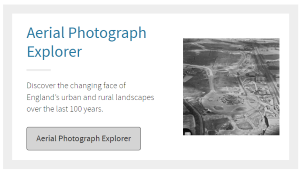 On 22 March 2022, Historic England launched its new Aerial Photography Explorer – which for the first time allows users to search and explore an online map showing aerial photographs of England over the past 100 years.
On 22 March 2022, Historic England launched its new Aerial Photography Explorer – which for the first time allows users to search and explore an online map showing aerial photographs of England over the past 100 years.
image: HE
… a fascinating insight into the development and expansion of the nation’s urban centres and changes to the rural landscape…
Historic England writes:
Aerial imagery provides a fascinating insight into the development and expansion of the nation’s urban centres and changes to the rural landscape. It can also reveal striking discoveries – such as ‘cropmarks’ showing hidden, archaeology beneath the surface.
New imagery available online includes:
- The remains of ancient archaeology such as a Neolithic long barrow near Broughton, Hampshire, as well as remains of Iron Age forts such as Pilsdon Pen in Dorset and medieval villages such as Old Sulby in Northamptonshire.
- Second World War anti-invasion measures such as anti-aircraft obstructions (ditches and earthworks) at Hampton Court Palace in 1941, and images from the same year of RAF Kenley showing camouflaged runways.
- Wartime adaptations to sites, for example, images of Greenwich Park in 1946 show it covered in a patchwork of allotments to grow food and aid the war effort. A modern photograph from August 2006 shows the outlines of the allotments appearing through the grass in hot weather.
- Bomb damage such as images of central Liverpool and the Albert Dock from 1941, 1946 and 1948 with flattened areas and buildings with roofs blown off. By contrast, aerial images from 2017 show the development of the area since.
- 20th-century industrial sites such as the construction of Tilbury power station in 1955, and its demolition in 2017.
- Famous buildings such as views of St James’ Park football stadium, Newcastle from the 1920s and St Paul’s Cathedral after the war.
Over 400,000 images from 1919 to the present day have been added to the tool, covering nearly 30% (about 15,000 square miles) of England, allowing people immediate digital access to Historic England’s nationally important collection of aerial photographs.
Around 300,000 of these are the work of Historic England’s Aerial Investigation and Mapping team. Established in 1967, the team takes photographs of England from the air to discover new archaeological sites, create archaeological maps and monitor the condition of historic sites across the country.
The remaining 100,000 images come from the Historic England Archive aerial photography collection, which numbers over six million images in total, and includes important historic photography, including interwar and post-war images from Aerofilms Ltd and The Royal Air Force.
By opening up these images to the public through this accessible online tool, Historic England hopes that people will use it to research their local areas, offering an insight into a century of changes and development. This will allow them potentially to make their own discoveries about their local areas. It will also provide industry professionals and local authorities with a useful resource to help planning, heritage projects and archaeological investigation.
“I am delighted that our new online tool will allow people to access easily our wonderful collection of aerial images and enjoy the historic photography that our team uses every day to unlock the mysteries of England’s past”
Duncan Wilson, Chief Executive Historic England
“What better way to discover our shared history than through this fascinating new online tool which offers a bird’s eye view of our past. I can’t wait to discover more about my local area and encourage everyone to explore the thousands of English sites from the last century”
Nigel Huddleston MP, Minister for Heritage
Over the coming years, Historic England aims to expand the platform, as more of the six million aerial images in Historic England Archive are digitised.
The Aerial Photography Explorer joins Historic England’s recently launched Aerial Archaeology Mapping Explorer to offer an unparalleled insight into England’s archaeology and the nation’s development.

